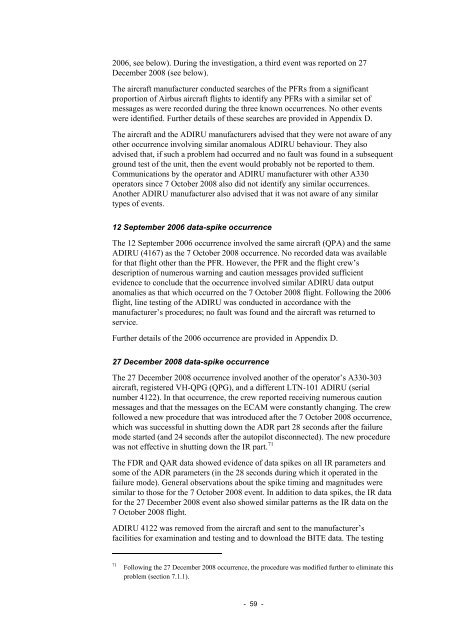In-flight upset - 154 km west of Learmonth, WA, 7 October 2008,
In-flight upset - 154 km west of Learmonth, WA, 7 October 2008,
In-flight upset - 154 km west of Learmonth, WA, 7 October 2008,
- No tags were found...
Create successful ePaper yourself
Turn your PDF publications into a flip-book with our unique Google optimized e-Paper software.
2006, see below). During the investigation, a third event was reported on 27December <strong>2008</strong> (see below).The aircraft manufacturer conducted searches <strong>of</strong> the PFRs from a significantproportion <strong>of</strong> Airbus aircraft <strong>flight</strong>s to identify any PFRs with a similar set <strong>of</strong>messages as were recorded during the three known occurrences. No other eventswere identified. Further details <strong>of</strong> these searches are provided in Appendix D.The aircraft and the ADIRU manufacturers advised that they were not aware <strong>of</strong> anyother occurrence involving similar anomalous ADIRU behaviour. They alsoadvised that, if such a problem had occurred and no fault was found in a subsequentground test <strong>of</strong> the unit, then the event would probably not be reported to them.Communications by the operator and ADIRU manufacturer with other A330operators since 7 <strong>October</strong> <strong>2008</strong> also did not identify any similar occurrences.Another ADIRU manufacturer also advised that it was not aware <strong>of</strong> any similartypes <strong>of</strong> events.12 September 2006 data-spike occurrenceThe 12 September 2006 occurrence involved the same aircraft (QPA) and the sameADIRU (4167) as the 7 <strong>October</strong> <strong>2008</strong> occurrence. No recorded data was availablefor that <strong>flight</strong> other than the PFR. However, the PFR and the <strong>flight</strong> crew’sdescription <strong>of</strong> numerous warning and caution messages provided sufficientevidence to conclude that the occurrence involved similar ADIRU data outputanomalies as that which occurred on the 7 <strong>October</strong> <strong>2008</strong> <strong>flight</strong>. Following the 2006<strong>flight</strong>, line testing <strong>of</strong> the ADIRU was conducted in accordance with themanufacturer’s procedures; no fault was found and the aircraft was returned toservice.Further details <strong>of</strong> the 2006 occurrence are provided in Appendix D.27 December <strong>2008</strong> data-spike occurrenceThe 27 December <strong>2008</strong> occurrence involved another <strong>of</strong> the operator’s A330-303aircraft, registered VH-QPG (QPG), and a different LTN-101 ADIRU (serialnumber 4122). <strong>In</strong> that occurrence, the crew reported receiving numerous cautionmessages and that the messages on the ECAM were constantly changing. The crewfollowed a new procedure that was introduced after the 7 <strong>October</strong> <strong>2008</strong> occurrence,which was successful in shutting down the ADR part 28 seconds after the failuremode started (and 24 seconds after the autopilot disconnected). The new procedurewas not effective in shutting down the IR part. 71The FDR and QAR data showed evidence <strong>of</strong> data spikes on all IR parameters andsome <strong>of</strong> the ADR parameters (in the 28 seconds during which it operated in thefailure mode). General observations about the spike timing and magnitudes weresimilar to those for the 7 <strong>October</strong> <strong>2008</strong> event. <strong>In</strong> addition to data spikes, the IR datafor the 27 December <strong>2008</strong> event also showed similar patterns as the IR data on the7 <strong>October</strong> <strong>2008</strong> <strong>flight</strong>.ADIRU 4122 was removed from the aircraft and sent to the manufacturer’sfacilities for examination and testing and to download the BITE data. The testing71Following the 27 December <strong>2008</strong> occurrence, the procedure was modified further to eliminate thisproblem (section 7.1.1).- 59 -



